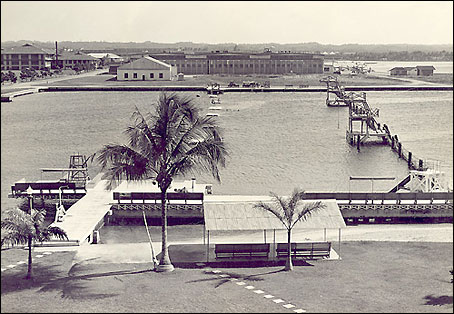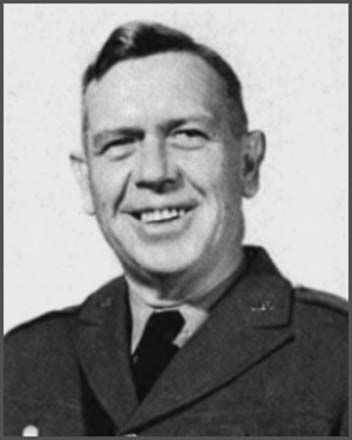I have previously written three articles about Frank Mahin. The first recounted how he had carved his name on a stone fireplace in the High School:
The second article had a title very similar to this present one, but it was called The Incredible Story of Frank Mahin, Volume I, 1887-1909.
After that, I wrote the next one in the series, imaginatively entitled The Incredible Story of Frank Mahin, Volume II, 1908-1920.
And now, Dear Reader, The Incredible Story of Frank Mahin, Volume III, 1921-1942:
A survivor of the horrors of the Great War, Frank Cadle Mahin immediately resumed his formal military studies. By 1925, and now promoted to Major Mahin, Frank was a “distinguished graduate” of the Command and General Staff School . He was graduated from the Army War College in 1929 and then became acting Inspector-General of the Panama Canal Department:
I do not know if Frank was available to attend the 25th annual reunion of the Class of 1909 at his old “Alma Mater”, Harvard University in June 1934. Hopefully, if he did, Frank was not there to renew his friendship with Ernst Hanfstaengl, the Harvard graduate, personal friend of Adolf Hitler and the man who took his book, “Mein Kampf”, to the top of the German bestseller lists. According to Wikipedia, Ernst Hanfsteangl also:
“helped to finance the publication of the NSDA’s official newspaper, the Völkischer Beobachter. Adolf Hitler himself was the godfather of Hanfstaengl’s son Egon. Hanfstaengl wrote both Brownshirt and Hitler Youth marches patterned after his Harvard football songs and, he later claimed, devised the chant “Sieg Heil”.”
In 1923, just over ten years before the reunion of the Class of 1909, after the failure of the Beer Hall Putsch, a wounded Adolf Hitler had fled to “Putzi” Hanfstaengl’s house in Uffing, a village a short distance outside Munich. Supposedly, Mrs Hanfstaengl managed to dissuade Adolf from committing suicide, when the police came to arrest him. (What a difference that might have made to the world!).
As you might imagine, at Harvard in 1934, there was a certain kerfuffle about this gentleman and his anti-Semitic views, and here are two websites where you can read about these events. Meanwhile, here’s “Putzi” chatting to a couple of his pals about the games in the next round of the German Soccer Cup. “Putzi”, on the left, is happy to play as goalkeeper, Adolf demands to be team captain as his inalienable right and new team signing Hermann Göring promises to lose fifty kilos and play up front, probably on the extreme right:
In 1937, Frank was placed in command of the 3rd Infantry Division, nicknamed the “Rock of the Marne”, soldiers who were later, in November 1942, to land with General Patton’s task force on the coast of Morocco:
They eventually overwhelmed the French Vichy defenders, in a highly contested amphibious landing, French fascist traitors v the Americans!
In 1939 Frank organized the 60th Infantry Regiment, the “Go Devils”, commanding them until October 1941, when he was promoted to Brigadier General:
The “Danville Bee” newspaper in Virginia carried a report of army war games played on June 6th 1941:
“WAR GAMES
BRAGG DIX UNITS MOVE INTO BATTLE
Red Forces of South Pitted Against Outnumbered Northern Blues
By JOHN DAFFRON BOWLING GREEN
June. A 14 mile no man’s land in northeastern Carolina soaked only by rain and reddened by of the north and south (sic) moved into bloodless battle today. At war technically since 5 p.m. yesterday when Second Army Corps Headquarters gave the word, the red forces of the south from Fort Bragg North Carolina pitted their motorized might against the three and a half to one superiority in manpower of the northern blue from Fort Dix New Jersey. There were 75 observers from the General Staff in Washington alone who with many other officers from the 28th and 29th divisions and the Second Army Corps staff moved out onto the battleground to watch the new army perform in modern manner. Planes of the 119th Observation Squadron from Newark New Jersey scouted the camouflaged position of the Ninth Division southerners In the woodland five miles east of here while flying observers from Bragg based at Richmond droned over the men of the north encamped around Rappahannock Academy Virginia. Northern planes were based at the Quantico Marine Base Virginia. As the units jockeyed for position and closed the separating gap over ground rich in Confederate war lore only one major factor separated the impending battle for Garand and Springfield rifles held blanks in their cartridge clips and the artillery loads were not capped by shells. The khaki clad southern forces wearing red arm bands were under command of Colonel F. C. Mahin. They included the 60th Infantry Battalion Company of the Ninth Medical, one platoon of Company C, 15th Engineers, one section of the Ninth Signal Corps and the second squadron of the Third Horse Cavalry from Fort Myer leant to the Ninth Division for the maneuvers. Northern forces under command of Major General C R Powell comprised the entire 44th Division. They wore blue fatigue uniforms for battle dress. They slogged over terrain made muddy and heavy by several days of sporadic rain. Ironically they moved through woodland blackened by the fires that swept Caroline county forests during the prolonged drought which was broken only last week.”
Frank became a Major General after assuming command of the 33rd Division, nicknamed the “Illinois Division” or the “Prairie Division” at Camp Forrest, Tennessee in May 1942:
Before his appointment, he had been assistant commander of the 45th Division, called “The Thunderbirds” at Camp Berkley in Texas:

Sadly, on July 24, 1942, the apparently very capable Frank Cadle Mahin and two Army flyers were killed near Waynesboro, Tennessee in the crash of their Army observation plane, a North American O-47, Serial number 37-337. The official report said that the casualties perished as a result of a forced landing caused by engine failure. This explanation bears out the researches carried out by Frank’s wife, Mauree Pickering Mahin (see below). Here is a North American O-47B of the 112th Observation Squadron, Ohio National Guard. It is preserved in the National Museum of the United States Air Force:
This is an O-47B painted for the army manoeuvres of June 1941, detailed in the report of the “Danville Bee” newspaper above. The insignia on the fuselage shows that the aircraft was hastily painted as a member of “red force”:
The fatal crash was reported as faraway as Perth, Western Australia, in their local newspaper, “The West Australian“:
Frank’s death was also reported on the front pages of local newspapers:
Mrs. Walter Brewer, wife of the Wayne County Sheriff, said:
“The plane struck a tree five miles west of here, but did not burn”.
The three occupants were en route from Tullahoma to Fort Sill, Oklahoma. An Army official identified the two others killed as the pilot, Second Lieutenant Robert F. Turk of Wichita, Kansas, and a second passenger, Sergeant John Camerford of Alamo, Texas, both attached to the 127th Observation Squadron, nicknamed the “Jayhawks”, at Tullahoma:
The 127th was a non-flying squadron operating the Distributed Common Ground System.
Frank’s wife, Mauree Pickering Mahin tells the harrowing tale in her autobiographical “Life in the American Army from the Frontier Days to Army Distaff Hall” :
“I had just fallen asleep when a knock came at the door and I saw Anna and Ernest come in so I knew something was wrong when I looked at their faces! I asked “Is it Dad?” and they both nodded “yes”. “Is he dead?” and again came the same reply. After a few minutes I said: “I think it’s better this way, as it is the way he would want to go; your dad was too intense a man to stand being incapacitated. Did it happen at Fort Sale?” Then Ernest spoke up: “No, Mother it happened at 10.30 this morning, in the mountains near Waynesboro, Tennessee.”
Mauree did her own research about the circumstances of the crash:
“The falling plane was seen by a man traveling on the road nearby, and he knew the terrain around there and was afraid the plane could not land safely any place, so he rushed to the scene and found all three occupants dead. He very quickly notified the Waynesboro Police and they notified the Camp Forrest Air Base. Then the Police immediately came out and picked up the three bodies and sent them on to Camp Forrest.
“And why did the Air Force cancel the Major’s promise to Dad that he would send Dad in his official four engine plane? No adequate explanation was given, and only a two engine plane was supplied. Dad’s chauffer remarked afterwards, that the engines sounded so terrible that he did not think the plane would ever get off the ground!”
Relatively few Old Nottinghamians have ever been murdered, and even fewer have perished as the result of a treasonous act:
“Not too long after that there was another similar accident from there, and an investigation revealed that one of the men who worked on both of those planes admitted he had done something to the engines of both of those planes, thus this was a real case of sabotage!”
I have not been able to trace what was done to this evil saboteur, but in most countries during time of war, the penalty would automatically have been death.
A memorial service was held for Frank at Camp Forrest, Tennessee on Saturday, July 25th, and then the family left for Washington later that afternoon. The interment in the National Cemetery at Arlington was on Tuesday, July 29th.
Major General Mahin is buried side by side with his son Colonel Frank Cadle Mahin Junior, a graduate of the West Point Class of 1944. The Major General is also commemorated in the Memorial Church at Harvard University. There is a list of the Harvard men who died in World War II, carved in stone on the wall at the right side of the church when facing the altar. There are ten columns. Frank has some very famous colleagues in this list, and it is very difficult to believe that he did not know them, given what must have been their common interest in all things military, and the fact that he, like them, was studying Law.
Since the High School was to abandon football at Christmas 1914, by his tragic death, Frank therefore became the only High School footballer to die during the Second World War. He is the only Old Nottinghamian to be awarded the Purple Heart and the only one to be interred in the National Cemetery at Arlington. I would also argue that Major General Mahin is the highest ranked Old Nottinghamian of all time.
His wife, Mauree, wrote this fitting epitaph:
“Thus ended thirty two years of faithful service given by a true soldier to his country. No soldier could have had a greater devotion to duty than did your Dad, and no matter where that duty called him he responded instantly. He died “with his boots on” which is exactly what he wanted to do!!
Incidentally, I believe that Mahin’s surname was pronounced “Marr-hin”. Certainly at West Point his son was often teased by his fellow cadets who all called him “Ma-Heen”.
















